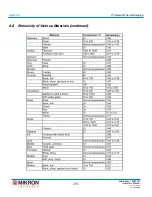
Section 8
275
MikroScan 7600PRO
Operator’s Manual
Catalog 11180-94
V15.4F 050406
Section
Principle of Thermal Imaging
All materials, which are above 0 degrees Kelvin (-273 degrees C), emit infrared energy.
The nfrared energy emtted from the measured object s converted nto an electrcal
sgnal by the magng sensor (mcrobolometer) n the camera and dsplayed on a montor
as a color or monochrome thermal image. The basic principle is explained as follows:
8.1 Infrared Radiation
The infrared ray is a form of electromagnetic radiation the same as radio waves, micro
-
waves, ultraviolet rays, visible light, X-rays, and gamma rays. All these forms, which
collectively make up the electromagnetic spectrum, are similar in that they emit energy
n the form of electromagnetc waves travelng at the speed of lght. The major dffer-
ence between each ‘band’ in the spectrum is in their wavelength, which correlates to the
amount of energy the waves carry. For example, while gamma rays have wavelengths
millions of times smaller than those of visible light, radio waves have wavelengths that
are bllons of tmes longer than those of vsble lght.
The wavelength of the infrared radiation ‘band’ is 0.78 to 1000µm (micrometers). This is
longer than the wavelength of vsble lght yet shorter that rado waves. The wavelengths
of infrared radiation are classified from the near infrared to the far infrared.
A Spectrum of Electromagnetic
Radiation
8
Summary of Contents for 7600PRO
Page 2: ......
















































